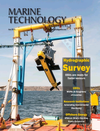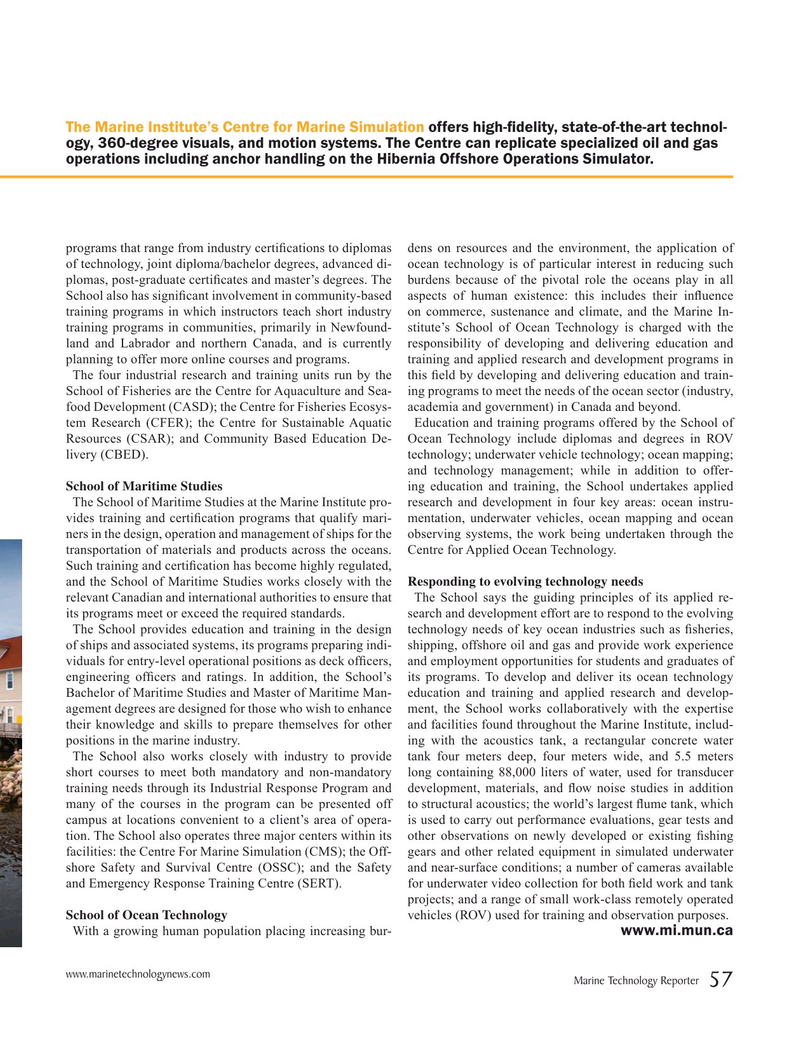
Page 57: of Marine Technology Magazine (June 2019)
Hydrographic Survey: Single & Multibeam Sonar
Read this page in Pdf, Flash or Html5 edition of June 2019 Marine Technology Magazine
The Marine Institute’s Centre for Marine Simulation offers high-? delity, state-of-the-art technol- ogy, 360-degree visuals, and motion systems. The Centre can replicate specialized oil and gas operations including anchor handling on the Hibernia Offshore Operations Simulator.
programs that range from industry certi? cations to diplomas dens on resources and the environment, the application of of technology, joint diploma/bachelor degrees, advanced di- ocean technology is of particular interest in reducing such plomas, post-graduate certi? cates and master’s degrees. The burdens because of the pivotal role the oceans play in all
School also has signi? cant involvement in community-based aspects of human existence: this includes their in? uence training programs in which instructors teach short industry on commerce, sustenance and climate, and the Marine In- training programs in communities, primarily in Newfound- stitute’s School of Ocean Technology is charged with the land and Labrador and northern Canada, and is currently responsibility of developing and delivering education and planning to offer more online courses and programs. training and applied research and development programs in
The four industrial research and training units run by the this ? eld by developing and delivering education and train-
School of Fisheries are the Centre for Aquaculture and Sea- ing programs to meet the needs of the ocean sector (industry, food Development (CASD); the Centre for Fisheries Ecosys- academia and government) in Canada and beyond.
tem Research (CFER); the Centre for Sustainable Aquatic Education and training programs offered by the School of
Resources (CSAR); and Community Based Education De- Ocean Technology include diplomas and degrees in ROV livery (CBED). technology; underwater vehicle technology; ocean mapping; and technology management; while in addition to offer-
School of Maritime Studies ing education and training, the School undertakes applied
The School of Maritime Studies at the Marine Institute pro- research and development in four key areas: ocean instru- vides training and certi? cation programs that qualify mari- mentation, underwater vehicles, ocean mapping and ocean ners in the design, operation and management of ships for the observing systems, the work being undertaken through the transportation of materials and products across the oceans. Centre for Applied Ocean Technology.
Such training and certi? cation has become highly regulated, and the School of Maritime Studies works closely with the Responding to evolving technology needs relevant Canadian and international authorities to ensure that The School says the guiding principles of its applied re- its programs meet or exceed the required standards. search and development effort are to respond to the evolving
The School provides education and training in the design technology needs of key ocean industries such as ? sheries, of ships and associated systems, its programs preparing indi- shipping, offshore oil and gas and provide work experience viduals for entry-level operational positions as deck of? cers, and employment opportunities for students and graduates of engineering of? cers and ratings. In addition, the School’s its programs. To develop and deliver its ocean technology
Bachelor of Maritime Studies and Master of Maritime Man- education and training and applied research and develop- agement degrees are designed for those who wish to enhance ment, the School works collaboratively with the expertise their knowledge and skills to prepare themselves for other and facilities found throughout the Marine Institute, includ- positions in the marine industry. ing with the acoustics tank, a rectangular concrete water
The School also works closely with industry to provide tank four meters deep, four meters wide, and 5.5 meters short courses to meet both mandatory and non-mandatory long containing 88,000 liters of water, used for transducer training needs through its Industrial Response Program and development, materials, and ? ow noise studies in addition many of the courses in the program can be presented off to structural acoustics; the world’s largest ? ume tank, which campus at locations convenient to a client’s area of opera- is used to carry out performance evaluations, gear tests and tion. The School also operates three major centers within its other observations on newly developed or existing ? shing facilities: the Centre For Marine Simulation (CMS); the Off- gears and other related equipment in simulated underwater shore Safety and Survival Centre (OSSC); and the Safety and near-surface conditions; a number of cameras available and Emergency Response Training Centre (SERT). for underwater video collection for both ? eld work and tank projects; and a range of small work-class remotely operated
School of Ocean Technology vehicles (ROV) used for training and observation purposes.
www.mi.mun.ca
With a growing human population placing increasing bur- www.marinetechnologynews.com
Marine Technology Reporter 57
MTR #5 (50-63).indd 57 5/28/2019 9:50:42 AM

 56
56

 58
58
